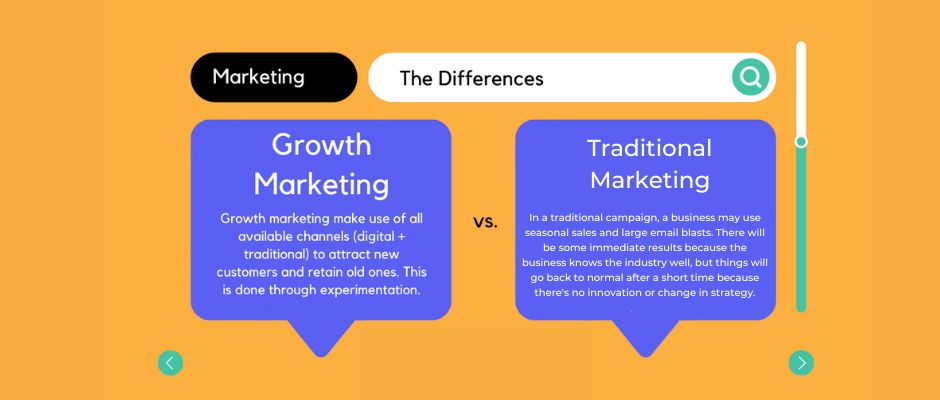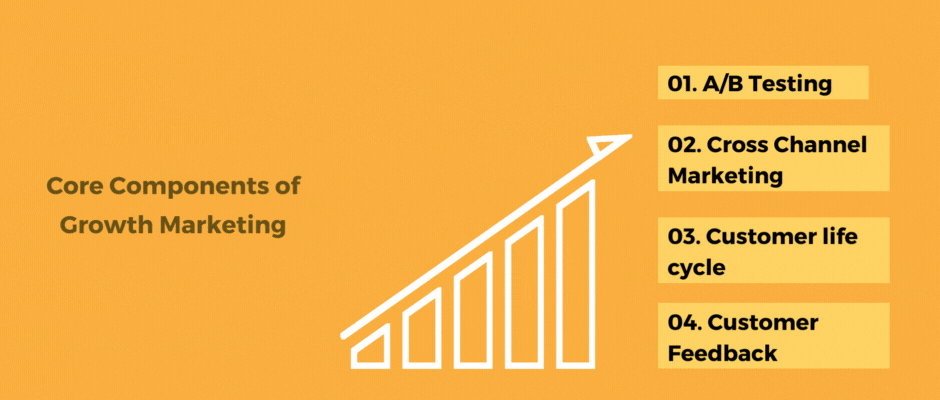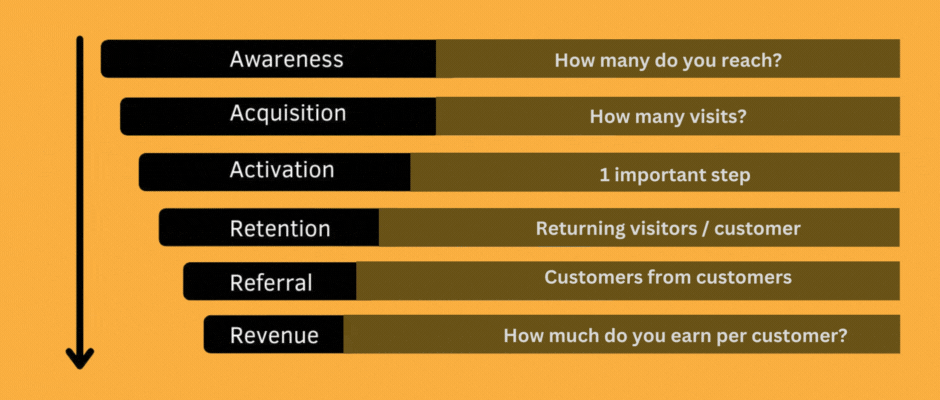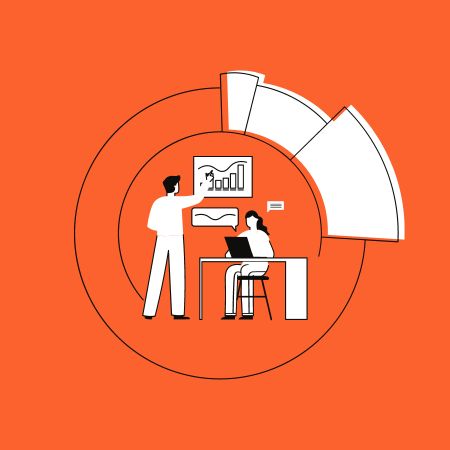
Actually, growth marketing is a long-term data-driven strategy that focuses on driving robust and sustainable growth for businesses. The ultimate goal of growth marketing is to identify the most efficient and effective ways to drive user acquisition and retention, rather than just building brand awareness. The two main factors of growth marketing are data and experimentation. Growth marketers run various continuous iterative experiments and gather data on customers’ behaviour, interest, intent, and market insights to get an understanding of customers and optimize customer journey touchpoints. With the right mix of tactics, growth marketing tactics can provide a snowball effect on businesses and their bottom line.

Essentially Growth marketing goes beyond traditional marketing methods. The main difference between growth marketing and traditional marketing is the focus on growth.
Traditional marketing focuses on the top of the funnel to drive brand awareness while growth marketing focuses on the full funnel to acquire, engage and retain customers and turn them into the champions of your brand; this means growth marketers involve in experimentation and use customer data-driven tactics and strategies at each stage of the funnel to rapidly scale their business. They work relentlessly to identify the innovative approaches that work best for their businesses.
Another key difference is in the traditional marketing decision-making approach is based on opinion or gut feeling, on the other hand, growth marketing is based on evidence which led to data-driven decisions.
Overall, growth marketing is a more agile and data-driven approach to marketing that is focused on driving sustainable and scalable growth. Traditional marketing, while still important, may not be as effective in a rapidly evolving digital landscape where consumers are increasingly empowered and demand more personalized and relevant experiences.

✅ A/B Testing
A/B testing also called a multivariate test, is one of the core components of Growth Marketing. Growth marketers use A/B testing to compare the two different versions. This involves testing option A against option B for example testing two different versions of landing pages, Ad copy, design, and other features. Once the growth marketer finds the best variation that drives greater engagement and conversion, they can then optimize future marketing efforts upon the effective variation to scale their growth plan.
✅ Cross Channel Marketing
Cross Channel Marketing focuses on prospects and current customers through multi-channels such as email marketing, Digital advertising campaigns, Social media, and other channels. While Integrating multi-channel marketing into your growth marketing strategy plan ensures the customer experience is consistent and relevant. One of the finest ways to provide a multi-channel experience is to implement a Conversational Marketing Platform.
✅ Customer lifecycle
The customer lifecycle is also an important part of growth marketing. The customer lifecycle is the journey that your customer goes through during their relationship with your brand. This involves how customers move through different stages of their customer journey, from becoming aware of the product to making a purchase and converting into a loyal customer. As a growth marketer, a crucial aspect is to identify the stages within the customer lifecycle that offer growth opportunities. To determine these stages, it is essential to analyze your business data thoroughly. By doing so, businesses can create effective marketing campaigns to accommodate the changing needs of customers at each stage.
✅ Customer Feedback
Another key component of Growth marketing is customer feedback. The ultimate goal of the growth marketing strategy is to build a long-term relationship with your customers. Gathering, customer feedback continuously gives you insights about what’s their experience and what’s making the frustrated. To gain insights quickly, data analysis is valuable, but interacting with customers directly can provide feedback much faster. You can collect customer insights through surveys, interviews, social listening, and focus group to identify what is working and what is not and based on their opinion to optimize your campaigns.

The Pirate Funnel is also called as AAARRR model which helps to scale your business and achieve exponential growth. It is mostly used by growth marketers to find their bottleneck and to find where to pay more attention. AAARRR frameworks track metrics across the customer journey from awareness, acquisition, activation, revenue, and retention to referral.
☑ Awareness
Awareness is the first stage of the funnel, where the customer interacts with your brand for the very first time and learns about your brand and solution, while businesses aim to make people aware of the product and create interest among them. You might have an excellent product that offers immense value but it can be challenging to acquire customers if they did not know about the product. Growth marketers need to focus on a cohesive approach to drive the customers to the awareness stage and retain them throughout the funnel.
For example, Growth marketers can run A/B testing to test which type of blog content or social media posts helps to generate more traffic and engagement.
☑ Acquisition
The acquisition is the process of attracting and converting potential customers into actual paying customers through personalized emails, gated content, giveaways, or sign up for a free trial. At this stage, businesses focus on increasing the customer base and revenue. This stage is very crucial for brands to achieve sustainable growth. So, they have to focus on the right audience.
☑ Activation
Activation is the third stage of the Pirate metric, it is a part of the customer onboarding process. At this stage, businesses convert the acquired customers into active and engaged customers. The main goal is to increase the customer experience. This is the process aiming active customers to use the product or service purchased as soon as possible. Growth marketers run experiments with different onboarding tactics like video demos, and personalized customer services to find what methods are most effective to activate your audience.
☑ Retention
The retention stage of the pirate funnel is to keep the customers engaged continuously and increase the customer lifetime value through continuous purchases. After customers have activated its crucial to retain them. Keeping the customers delighted is a key component of a growth marketing strategy, it’s also important to acquire new users but at the same time, it’s essential to generate revenue from the existing customers. Data enrichment and customer data science assist growth marketers to gather insights about customer opportunities and creating growth marketing strategies like continuous customer support and releasing new product features.

Once you have a base of loyal customers, the next step is to focus on generating revenue, where businesses need to monetize their offerings and convert active customers into paying customers. In order to increase sales or revenue streams, growth marketers can experiment and improve pricing strategies by offering premium features, upselling the current customers and developing new price models.
It is crucial to understand that the revenue stage is highly dependent on the previous stages specifically activation and retention. A business will struggle If a business failed to activate and retain its customers. Therefore, it’s important to have a sound knowledge of how all these stages work together to achieve sustainable growth.
☑ Referral
The referral stage is the final stage in the customer journey, where loyal customers play a role as brand ambassadors to refer your products and services to new customers. Meantime growth marketers can experiment with different referral programs by offering incentives or promotional methods like discounts, free upgrades, vouchers, or cash back to customers who refer your business to others. This kind of innovative approach helps to increase referral rates.
🔔 Wrapping Up
To sum up, Growth marketing is a powerful strategy for businesses that thrive to scale and achieve sustainable growth. With the best combination of data-driven insights and experimentation growth marketing helps to attract, acquire, activate, and retain customers to accelerate growth. If you are looking to scale your business and want to increase your ROI, but are unsure where to begin? Start your growth marketing journey today and unleash the full potential of growth marketing to take your business to next level.






Comment(01)
Lots of talk about growth hacking VS growth marketing and most of them misunderstood thinking like both are the same process! You’ve perfectly articulated in a detailed breakdown. Good one.